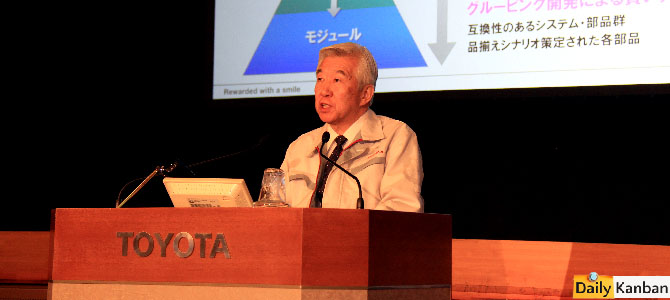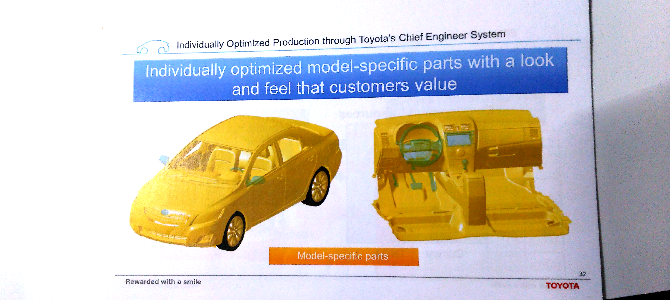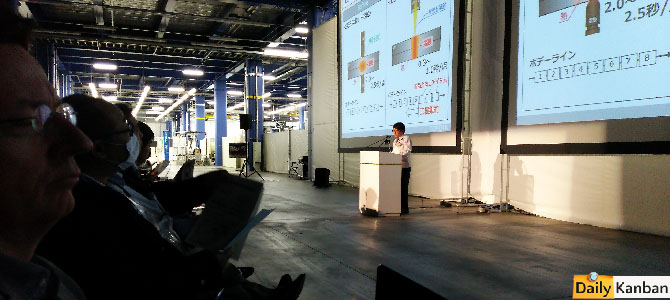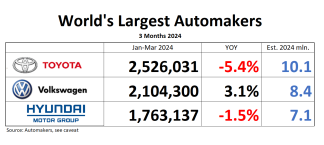Yesterday, Toyota trucked a few busloads of journalists to Toyota City to unveil the Toyota New Global Architecture. Those who didn’t go, and who used the press release to write about common parts, missed the story. Those who expected a Japanese version of MQB, went home disappointed, or confused. Those who followed prior hints that production engineering plays an essential part in TNGA, with the aim of increasing a plant’s output and flexibility, while keeping CAPEX in check, were not surprised. In a full day of presentations, we saw very little hard evidence of modular systems. What we heard, saw, and could touch was living, working, grinding and stamping proof of TPS 2.0, a new-millennium-ready version of Toyota’s vaunted production system.

The boys on the bus. The tweeting man on the right is Reuters’ future Whitehouse reporter Kevin Krolicki
There were two big presentations. One was about products, given by Toyota’s dapper R&D EVP Mitsuhisa Kato. The other was about production, delivered by a nerdy Hirofumi Muta, chief of Toyota’s secretive production engineering group.
In the days prior, contacts at Toyota wisely had down-managed expectations into the first part, while recommending high alert for the second. They were right on, as usual. Kato gave his presentation at the Toyota Kaikan Museum, and the venue was well chosen. Large parts of the speech were antique, many of the slides were classics. The speech wasn’t live-streamed this time, but if you watch the recording of two years ago, you will see most of what we saw yesterday.
Kato promised cars with a 25 percent better fuel efficiency, and with a 15 percent better performance. Future cars will have a lower center of gravity, better transmissions, fuel injection and superchargers, all of which is commendable, but has nothing to do with modularization, or building cars from Legos.
Martin Koelling, Tokyo correspondent of Germany’s Handelsblatt, asked Kato about what sets TNGA apart from known modular systems like Nissan’s CMF, or Volkswagen’s MQB. Kato could not explain, instead, he said he hopes the media could explain it for him. Alright, here is my attempt:
TNGA is no modular system as one would expect. Toyota still has platforms, maybe a few less, but platforms they are nonetheless. The peanut gallery in carblogs doesn’t even have to start the handwringing about the soul of the car being sold to the devil in the common parts bin. Kato had a slide that showed common parts in green/blue, and individual parts in yellow. Result, see above.
The revolutionary part of TNGA is not the kaizen-continuously-improved product, the revolution is a new production process where the small and sprightly slay the long-tailed fire-belching dragon of the old assembly line. Production engineering is the under reported, but über-important element of the car business. It is where Toyota excelled, and it is where Toyota will excel even more.
At the heart of TPS 2.0 is a trim and nimble factory, downsized to around 200,000 units per year, but capable of making eight or more models at the same time on the same line. That factory looks pretty much like Toyota’s Miyagi plant near Sendai, which I could visit four years ago. That plant has no deep pits, no overhead rigging. The assembly line is bolted into the floor. To increase capacity, the line can be made longer, over the weekend. It can be made shorter when demand ebbs. Push comes to shove, the assembly line can be unbolted, loaded into containers, and shipped elsewhere, where it is needed more.
Toyota has mastered the compact car, mainly through miniaturization and smart packaging. Now, Toyota masters the compact car factory, by doing the same thing. The TNGA factory is filled with equipment that does the same job with less energy, less effort, demanding less space and money. Take the paint line. A typical paint line is some 10 meters high, and a nearly two football fields long monster. The TNGA paint line is only 6.5 meters high, and a little more than one football field long.
Or take hot press forming. In hot press forming, an oven produces a line of high-temperature-heated steel sheets, which get stamped, and then rapidly cooled in the mold. It makes for high strength stampings, but it is a monstrosity of an apparatus, and it takes a lot of energy for heating and cooling. Toyota runs electricity through the metal sheet, which makes it heat up in seconds just like a hot plate. The process shrinks from minutes to seconds, the line length shrinks from some 30 meters to three. The investment shrinks by 30 percent.
Or take something as profane as a wiring harness, something that is made in a profane process, by wrapping tape around bundles of wires, manually, typically in very low cost countries like Africa, with supply-lines and lead-times halfway around the globe. Toyota developed an automated tape wrapping machine that allows TNGA wire harnesses made quickly, nearby, and in small batches.
I wish I could show you pictures, but Toyota guards production secrets more than other car companies guard their clay models, and a ban against any recording devices was strictly enforced this time. It’s a shame, because among the multitude of processes we saw yesterday hands-on, demonstrated by the enthusiastic people who developed them, were a few that point into a future of manufacturing that may very well leapfrog even the most sophisticated assemblage of modules and kits.
The challenge of carmaking is that the car consists of 20,000 to 30,000 parts, which need a similar number of tools, dies, molds and manufacturing processes. As any automaker quickly realizes, the business makes only sense if you make a lot of these parts and cars, and the longer you can make them, the more money you can make. Then, the darned customer ruins your business. The customer demands new product in ever quicker succession. The customer wants unique products. The customer is fickle, tastes change. You build factories when demand is red hot, and when the factory is finished, demand cools down, and you are finished. What if you could do away with the tools, dies, molds? What if you could cut down on making stockpiles of parts?
Yesterday, we saw a machine that makes different bumpers one piece at a time, as needed by the different cars that come down the same line. No more inventory, no more ordering, the machine spits out the bumper as required by the car coming down the line, and it makes the bumper according to the computer program that runs the manufacturing process. The machine can change the required molds quickly. But it still needs molds.
Then, we saw another machine that does away with molds. It looks like a throwback to the first days of sheet metal bending, where craftsmen hammered the metal into form. Except now, the hammering is done by robots, according to digital dies that exist only in a computer brain that guides the robot. 3D printing has the right idea, but cars are not all made from molten plastic. What sounds like a far-away future (or a long-gone past) has quietly been in the works since 2012, making parts for low volume, but high margin cars like the Lexus RC F, the iQ GFMN Supercharger, or the Vitz GRMN. The hammering robots are ready for prime time.
Actually, most of the 26 different processes we saw yesterday have quietly been implemented over the past few years in different factories, most of them in Japan. The Miyagi plant, the Tsutsumi plant, Toyota’s Takaoka and Tahara plants were test beds since 2011, and now the technologies, and a few more we were not shown, are being rolled out into Toyota factories around the globe. This being Toyota, they go slow. A 50 percent rollout is expected by 2020, and “I sometimes wonder when we can implement TNGA 100 percent,” Kato said yesterday. “We’ll just have to implement it as quickly as possible.”
Coming home on the Shinkansen after a very long day in Toyota City, it suddenly became clear in my fried brain why Toyota had issued a stop to building new factories, not to be lifted before 2016. Carmageddon, or “the Lehman shock” as they say at Toyota, triggered a company-wide post-traumatic stress disorder. Recalls, earthquakes, floods, riots in China are long digested. The horror of sitting on a mountain of unused capacity still gives them sleepless nights, and, in a healing process, it is talked about all day. The patient has recuperated. Toyota used the time to prepare for a future where one can do more with less, where one can adapt to the peaks and valleys of demand, instead of praying for better times.
And what’s the bottom line? With TNGA, Toyota thinks it can reduce CAPEX necessary for new plants by 40 percent. The cost of a model switchover can be cut in half, and the time to do it is close to nothing.
And what will Toyota do with all the money it saves? “The purpose of TNGA is not to share common parts and to reduce cost,” Kato said yesterday. “Capital gained in streamlining will be reinvested into making better cars.” And ever better car factories.
Where does this leave the competition? Companies that have done their modularization homework like Volkswagen, or Nissan, are ready to compete. Nissan probably better, its CMF system has the same “save the CAPEX” idea, while Volkswagen’s MQB is more a Teutonic “out with the old, in with the new.” Japanese and European carmakers are used to build to order. Companies that are still wedded to the assembly line of old, and to using the dealer as a depository for production overruns, will have a hard time. The next crash could break their necks. Newcomers should wait a while until the small and nimble car factories are as common as inkjet printers.
No, TNGA is not a modular system. As Hirofumi Muta said, “TNGA is the next step from TPS.” Thank you for writing my headline.










